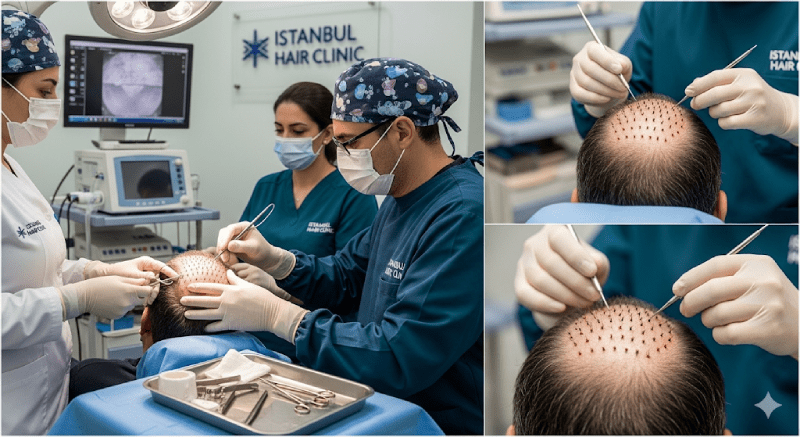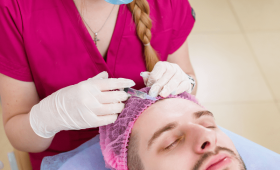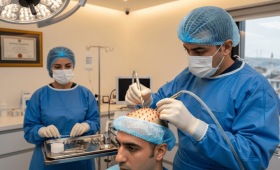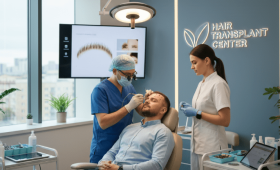What is Hair Transplantation?
Hair transplantation is the process of transplanting hair follicles (grafts) resistant to hair loss, usually taken from the back or sides of the head, to bald or thinned areas. This surgical procedure offers a definitive and natural solution for permanent hair loss caused by genetic factors such as androgenetic alopecia (male pattern baldness). A graft is a piece of tissue that can contain one to four hair follicles. Since the procedure is performed with the patient’s own hair follicles, there is no risk of rejection by the body, and the newly transplanted hairs maintain their permanence for life by continuing their natural hair cycle.
Who Can Get a Hair Transplant?
The most suitable candidates for a hair transplant are determined after a careful preliminary evaluation. The criteria include:
- Age: It is generally applied to individuals aged 18 and over. However, since the hair loss process can continue until the age of 20-22, it is usually recommended to wait for this period to be over to obtain more permanent results.
- General Health Status: It may not be suitable for people with serious chronic health problems such as heart disease, blood clotting disorders, or uncontrolled diabetes. Blood tests and a general health check are performed before the procedure.
- Sufficiency of the Donor Area: This is one of the most important criteria. It is necessary to have a donor area (usually the back of the head) with a sufficient number of healthy and strong hair follicles to cover the bald area. The denser the donor area, the more successful the result after transplantation.
- Type of Hair Loss: The procedure is generally effective for permanent hair loss types (androgenetic alopecia). Hair transplantation is not recommended for hair loss caused by the immune system, such as alopecia areata, or temporary hair loss due to stress.
What Methods Are Used?
The two most advanced methods in the field of hair transplantation are:
- FUE (Follicular Unit Extraction): In this method, hair follicles from the donor area are extracted one by one with a special micro-motor with a tip of 0.6 mm to 1.2 mm in diameter or a manual punch tool. Then, thin channels are opened in the bald area at angles suitable for the natural direction of hair growth, and the collected grafts are carefully placed into these channels. FUE is a technique that can be applied to large areas and leaves no scars.
- DHI (Direct Hair Implantation): In the DHI method, a special medical pen called the “Choi Implanter Pen” is used. Hair follicles are collected one by one, immediately placed into the pen tip, and directly implanted into the recipient area. In this technique, since there is no pre-channel opening stage, the procedure is faster and the hair follicles remain outside the body for a shorter time. DHI is ideal for making dense transplants, especially between existing hairs.
Does Hair Transplantation Hurt?
Hair transplantation is performed under local anesthesia to ensure patient comfort.
- During Anesthesia: A slight stinging sensation may occur during the injection of the anesthetic, but this passes in a few seconds. The operation area is then completely numb.
- Painless Anesthesia: In some clinics, the anesthesia can be made more comfortable by using needle-free jet injection systems.
- During the Procedure: As long as the effect of the anesthetic continues, no pain or ache is felt. The patient can listen to music or watch a movie during the operation.
- After the Operation: After the effect of the anesthetic wears off, a slight tension or ache may be felt. This can be easily managed with simple painkillers prescribed by the doctor.
How Long Does the Procedure Take?
The duration of the hair transplant operation varies according to the personalized planning and generally takes 6 to 8 hours. This time is shaped by the following stages:
- Anesthesia Application: 15-20 minutes.
- Graft Collection: Approximately 2-3 hours.
- Channel Opening (for FUE): Approximately 1 hour.
- Graft Implantation: Approximately 2-3 hours.
- Rest Breaks: The patient is given breaks as needed during the operation.
What is the Healing Process Like After a Hair Transplant?
The healing process is vital for the success of the operation.
- First 1-2 Days: Slight swelling, redness, and small scabs due to blood clotting around the grafts occur in the transplanted area.
- First 10 Days: The “Scab Shedding” process begins. During this period, the scabs gradually fall off, and the transplanted hairs become more visible. It is essential to avoid picking or scratching the scabs, as this can damage the grafts.
- 2-3 Weeks: A process called “shock shedding” begins, where a large portion of the transplanted hair falls out. This is a natural and expected process for the hair follicles to adapt to their new location and there is no need to worry.
- 1 Month: The donor area is completely healed, and the hair returns to its original length.
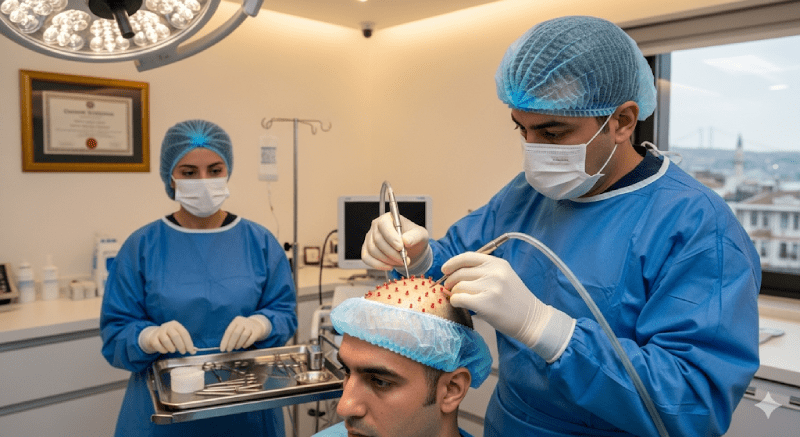
When Do Transplanted Hairs Start to Grow?
After the shock shedding process is complete, the new hairs enter the growth cycle:
- 3rd Month: The first hairs, very thin and weak like “peach fuzz,” start to grow.
- 6th Month: Approximately 50-60% of the transplanted hair has grown and thickened. At this stage, the results begin to become apparent.
- 1 Year: All transplanted hairs have grown, thickened, and reached their natural density. The final and most complete result of the hair transplant is seen during this period.
Is Hair Transplantation Permanent?
Yes, the hair transplant procedure is permanent for life. The main reason for this is that the transplanted hair follicles are genetically resistant to the hormone dihydrotestosterone (DHT). As a result, they are not affected by the hormones that cause hair loss and continue to live without falling out in their new location. The transplanted hair continues to grow, be cut, and styled just like natural hair.
Will There Be Hair Loss in the Donor Area?
No, when done by an experienced team, there will be no visible hair loss in the donor area. Experts collect hair follicles evenly and sparsely to maintain the overall density of the donor area. As long as over-harvesting is not done, the donor area retains an aesthetic appearance.
What is the Ideal Age Range for Hair Transplantation?
The most ideal period for hair transplantation is between the ages of 25-45, when hair loss has largely stopped or slowed down. At younger ages (18-24), hair loss may continue, and new hair loss may occur in later years, requiring another session.
Does Hair Transplantation Provide a Natural Look?
Yes, when applied by a professional team, hair transplantation provides a highly natural look. The factors that determine the naturalness are:
- Hairline Design: It is very important to create a natural hairline that is suitable for the facial structure, age, and movement of the forehead muscles.
- Direction and Angle of Hair Implantation: Hair follicles should be transplanted in a way that is consistent with the natural growth angle and direction of the hair.
- Density and Richness: The correct distribution of grafts at the right density ensures a fuller and more natural-looking result.
What Should I Pay Attention to After a Hair Transplant?
It is important to follow these instructions to support the healing process:
- For the first 3 days, lie on your back and prevent the transplanted area from rubbing against the pillow.
- The first wash should be done 24-48 hours after the operation with special shampoos and lotions recommended by the doctor.
- Avoid activities that cause excessive sweating, such as sports, swimming, and saunas, for the first month.
- Protect yourself from sunlight and excessively hot environments.
- Protect the transplanted area from hard impacts and friction.
Why Are Smoking And Alcohol Consumption Not Recommended After Hair Transplantation?
These substances seriously negatively affect the healing process:
- Smoking: Nicotine constricts blood vessels, which prevents the hair follicles from receiving the oxygen and nutrients they need. This can reduce the survival rate of the grafts and slow down wound healing.
- Alcohol: It thins the blood, increasing the risk of bleeding during and after the operation. It can also weaken the immune system, which increases the risk of infection.
Can a Hair Transplant Be Unsuccessful?
As with any surgical procedure, there are risks in hair transplantation. Unsuccessful outcomes are generally attributed to the following reasons:
- Low Graft Survival Rate: A large portion of the hair follicles not taking root after transplantation.
- Incorrect Technique Application: Mistakes such as wrong hair implantation direction or hairline design.
- Lack of Patient Compliance: Not following the instructions for the healing process.
Choosing the right clinic and an experienced surgeon is vital to minimize these risks.
How Are Hair Transplant Prices Determined?
Prices are not dependent on a single criterion and vary according to many factors. These factors include:
- Number of Grafts to be Transplanted: This is usually the basis of the pricing.
- Method to be Used: There may be cost differences between the FUE and DHI methods.
- Experience of the Clinic and Doctor: The price of a specialized and reputable surgeon may be higher.
- Additional Services: Some packages may include additional services such as accommodation, medication, and washing.
What to Consider When Deciding to Get a Hair Transplant
Deciding to get a hair transplant is a significant step. To complete this process successfully and safely, there are several important factors you should consider. Here’s what to keep in mind during the decision-making phase:
Health Status and Suitability
Although a hair transplant is a minor surgical procedure, your general health must be suitable. If you have chronic conditions (diabetes, high blood pressure, heart disease, etc.), it is very important to first consult with your doctor to evaluate the situation. Additionally, you need to have a sufficient donor area (the area from which hair follicles will be taken) for the transplant. If your donor area is insufficient or your hair loss is too advanced, the procedure may not be right for you.
Choosing a Clinic and Doctor
A hair transplant should absolutely be performed by a specialist doctor and a competent team. When making your decision, pay attention to these points:
- Experience and Expertise: It is crucial that the doctor performing the procedure is experienced and specialized in hair transplantation.
- Clinic Conditions: The clinic where the operation will take place must be in a sterile environment that meets hygiene standards and has modern equipment.
- References and Reviews: Check the experiences and comments of people who have previously had a hair transplant. Verify the clinic’s and the doctor’s references.
The Technique Used and Pricing
Different techniques (FUE, DHI, etc.) are used in hair transplantation. Each technique has its own advantages and disadvantages. You should decide on the most suitable technique for you in consultation with your doctor. Pricing varies from clinic to clinic, depending on the technique used and the number of grafts to be transplanted. Instead of focusing solely on the price, also consider the quality and safety factors mentioned above.
Post-Operative Process and Expectations
The success of a hair transplant is not limited to the operation itself. It requires a careful post-operative care process. Following your doctor’s instructions meticulously will speed up the healing process and help you achieve the best results. Also, remember that the results will not be immediately visible, and the final outcome will appear 12 to 18 months later. Having realistic expectations will prevent disappointment after the operation.
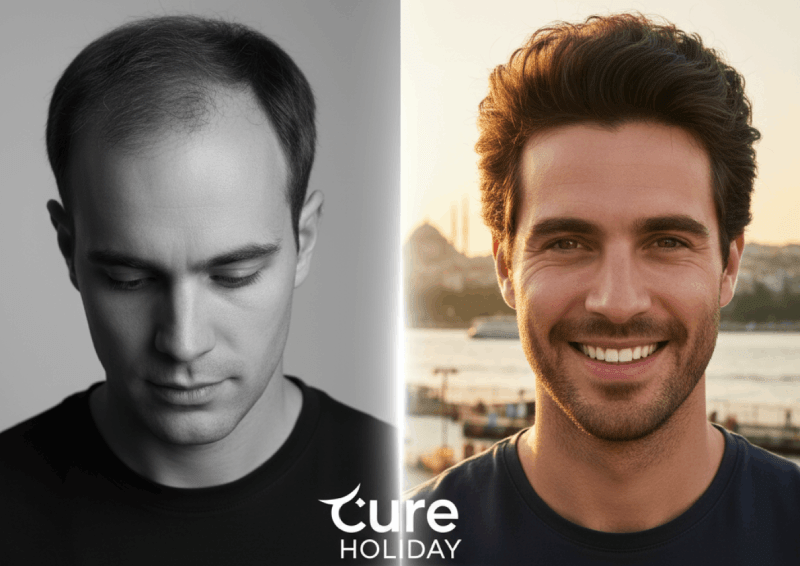
Turkey or UK for Hair Transplantation?
Hair Transplantation Cost In Turkey
- Turkey: Hair transplant prices are significantly more affordable compared to the UK. This is primarily due to the country’s lower cost of living and the favorable exchange rate for foreign patients. Clinics in Turkey often offer “all-inclusive” packages. These packages may include the procedure itself, airport transfers, luxury hotel accommodation, all necessary medications, and post-operative care products. This approach makes the cost transparent and predictable, which is very appealing to patients.
- UK: Hair transplant procedures are much more expensive than in Turkey due to higher labor and operational costs. Pricing typically covers only the surgical procedure, with extra services (accommodation, medications, etc.) requiring additional payment.
Hair Transplant Quality and Expertise in Turkey
Regardless of the cost, the quality of the procedure and the surgeon’s expertise are the most crucial aspects.
- Turkey: Thanks to the high volume of annual operations, Turkey has become a global hair transplant hub. This allows surgeons to gain extensive experience and expertise on various hair types and conditions. The latest techniques like FUE (Follicular Unit Extraction) and DHI (Direct Hair Implantation) are widely used. However, due to the high number of clinics, the quality can vary. Therefore, it is essential to thoroughly research the clinic’s accreditation and the surgeon’s certifications.
- UK: Clinics in the UK operate under very strict regulations and high standards. Regulatory bodies like the CQC (Care Quality Commission) help guarantee service quality and patient safety. Surgeons are highly educated and well-versed in medical literature. However, since the volume of operations is not as high as in Turkey, some surgeons may have a more limited range of experience.
Regulations and Safety for Hair Transplantation in Turkey
Safety is a fundamental expectation when receiving medical services.
- Turkey: The Turkish Ministry of Health regulates and supervises the activities of hair transplant clinics and surgeons. When you choose a reputable and licensed clinic, you can be confident that the procedures comply with international standards. Clinics are subject to strict rules regarding sterile environments and the use of disposable equipment.
- UK: All medical procedures in the UK are strictly regulated and audited by the CQC and the GMC (General Medical Council). These audits provide an extra layer of security and assurance for patients. There are clear processes in place for reporting and resolving medical errors.
Logistics and Post-Operative Care
The pre- and post-operative stages are just as important as the procedure itself.
- Turkey: Traveling to Turkey is easy, especially for those coming from Europe. Most clinics simplify the process by handling logistical needs like airport transfers and accommodation. However, you may need to travel again for follow-up appointments or communicate remotely, which can make it difficult to manage potential complications in person.
- UK: The entire process is much easier for residents of the UK. You can easily attend all pre- and post-operative appointments and communicate with your surgeon face-to-face. This close proximity, especially during the sensitive first few days after the operation, allows for immediate intervention if any issues arise and provides psychological comfort to the patient.
Comparison Table
| Feature | UK | Turkey |
|---|---|---|
| Cost | Quite High, only covers the procedure | Very Affordable, usually “all-inclusive” packages |
| Expertise | Highly trained, but lower operation volume | Specialized due to high operation volume |
| Regulations | Very strict supervision by CQC and GMC | Strict supervision by Ministry of Health |
| Logistics | Easy for local patients, no travel stress | Requires travel and accommodation planning |
| Post-Op Care | Easily accessible and face-to-face follow-up | Remote or may require extra travel |
Hair Transplant Costs Turkey vc UK
Hair transplantation is an aesthetic procedure that has become increasingly popular in many countries, particularly in Turkey and the UK. The cost difference between these two countries is a significant factor for anyone considering the operation.
Hair Transplant Costs in Turkey
Turkey is one of the world leaders in hair transplantation, a reputation it largely owes to its affordable prices. While prices vary depending on the number of grafts, the technique used (FUE, DHI, etc.), and the clinic’s popularity, the average cost ranges from $2,000 to $5,000 USD. This price often includes packages with accommodation, transfers, and post-operative care. This makes Turkey a very attractive destination for hair transplantation.
The hair transplant sector in Turkey has become a vital part of its medical tourism. Thanks to intense competition and government incentives, clinics can offer high-quality services at more reasonable prices. Moreover, operations are often performed by experienced and expert surgeons. This makes Turkey an ideal choice for those seeking both cost benefits and quality results.
Hair Transplant Costs in the UK
In contrast, hair transplant costs in the UK are significantly higher than in Turkey. The average cost in the UK can range from £6,000 to £15,000 GBP. The main reasons for this price difference include high labor costs, clinic operating expenses, and the general cost of living. Pricing in the UK is typically determined by the number of grafts to be transplanted in a single session, and additional services (like accommodation) are often not included in this price.
Anyone looking to get a hair transplant in the UK must also separately plan for accommodation, travel, and other expenses, which further increases the total cost. Despite the high prices, some people may prefer the UK due to its geographical proximity and language advantages.
Reasons for the Cost Difference
The primary factors creating the cost difference between these two countries are:
- Cost of Living and Operating Expenses: The high cost of living and operating expenses in the UK lead clinics to charge more for their procedures. In Turkey, these costs are much lower.
- Competition: The number of hair transplant clinics in Turkey is quite large. This intense competition keeps prices at a reasonable level. The UK does not have such a competitive environment.
- Exchange Rates: Hair transplant procedures in Turkey are priced in foreign currencies (USD, EUR, GBP), making the operation more economical for patients coming from the UK due to favorable exchange rates.
